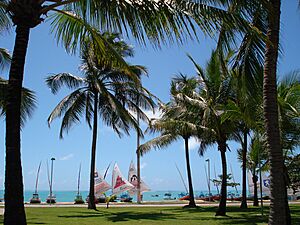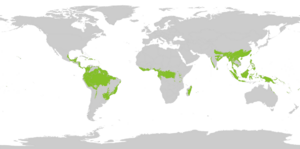Tropics facts for kids
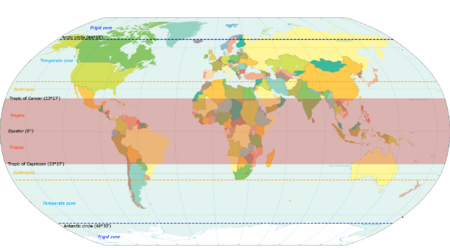
The tropics are the regions of Earth surrounding the Equator. They are defined in latitude by the Tropic of Cancer in the Northern Hemisphere at Template:Circle of latitude N and the Tropic of Capricorn in the Southern Hemisphere at Template:Circle of latitude S. The tropics are also referred to as the tropical zone and the torrid zone (see geographical zone).
In terms of climate, the tropics receive sunlight that is more direct than the rest of Earth and are generally hotter and wetter as they aren't affected as much by the solar seasons. The word "tropical" sometimes refers to this sort of climate in the zone rather than to the geographical zone itself. The tropical zone includes deserts and snow-capped mountains, which are not tropical in the climatic sense. The tropics are distinguished from the other climatic and biomatic regions of Earth, which are the middle latitudes and the polar regions on either side of the equatorial zone.
The tropics constitute 39.8% of Earth's surface area and contain 36% of Earth's landmass. As of 2014[update], the region was home also to 40% of the world's population, and this figure was then projected to reach 50% by 2050. Because of global warming, the weather conditions of the tropics are expanding with areas in the subtropics, having more extreme weather events such as heatwaves and more intense storms. These changes in weather conditions may make certain parts of the tropics uninhabitable.
Contents
Etymology
The word "tropic" comes via Latin from Ancient Greek τροπή (tropē), meaning "to turn" or "change direction".
Astronomical definition

The tropics are defined as the region between the Tropic of Cancer in the Northern Hemisphere at Template:Circle of latitude N and the Tropic of Capricorn in the Southern Hemisphere at Template:Circle of latitude S; these latitudes correspond to the axial tilt of the Earth.
The Tropic of Cancer is the Northernmost latitude from which the Sun can ever be seen directly overhead, and the Tropic of Capricorn is the Southernmost. This means that the tropical zone includes everywhere on Earth which is a subsolar point at least once during the solar year. Thus the maximum latitudes of the tropics have equal distances from the equator on either side. Likewise, they approximate the angle of the Earth's axial tilt. This angle is not perfectly fixed, mainly due to the influence of the moon, but the limits of the tropics are a geographic convention, and their variance from the true latitudes is very small.
Seasons and climate
Many tropical areas have both a dry and a wet season. The wet season, rainy season or green season is the time of year, ranging from one or more months when most of the average annual rainfall in a region falls. Areas with wet seasons are disseminated across portions of the tropics and subtropics, some even in temperate regions. Under the Köppen climate classification, for tropical climates, a wet-season month is defined as one or more months where average precipitation is 60 mm (2.4 in) or more. Some areas with pronounced rainy seasons see a break in rainfall during mid-season when the intertropical convergence zone or monsoon trough moves poleward of their location during the middle of the warm season; Typical vegetation in these areas ranges from moist seasonal tropical forests to savannahs.
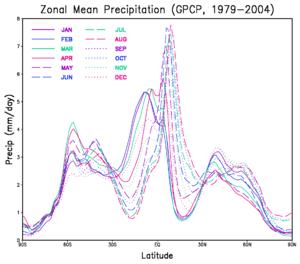
When the wet season occurs during the warm season, or summer, precipitation falls mainly during the late afternoon and early evening hours. The wet season is a time when air quality improves, freshwater quality improves and vegetation grows significantly due to the wet season supplementing flora, leading to crop yields late in the season. Floods and rains cause rivers to overflow their banks, and some animals to retreat to higher ground. Soil nutrients are washed away and erosion increases. The incidence of malaria increases in areas where the rainy season coincides with high temperatures. Animals have adaptation and survival strategies for the wetter regime. The previous dry season leads to food shortages into the wet season, as the crops have yet to mature.
However, regions within the tropics may well not have a tropical climate. Under the Köppen climate classification, much of the area within the geographical tropics is classed not as "tropical" but as "dry" (arid or semi-arid), including the Sahara Desert, the Atacama Desert and Australian Outback. Also, there are alpine tundra and snow-capped peaks, including Mauna Kea, Mount Kilimanjaro, Puncak Jaya and the Andes as far south as the northernmost parts of Chile and Perú.
Climate change
The climate is changing in the tropics, as it is in the rest of the world. The effects of steadily rising concentrations of greenhouse gases on the climate may be less obvious to tropical residents, however, because they are overlain by considerable natural variability. Much of this variability is driven by the El Niño-Southern Oscillation (ENSO). The Tropics has warmed by 0.7-0.8°C over the last century—only slightly less than the global average—but a strong El Niño made 1998 the warmest year in most areas, with no significant warming since. Climate models predict a further 1-2°C warming by 2050 and 1-4°C by 2100.
Ecosystems
Tropical plants and animals are those species native to the tropics. Tropical ecosystems may consist of tropical rainforests, seasonal tropical forests, dry (often deciduous) forests, spiny forests, deserts, savannahs, grasslands and other habitat types. There are often wide areas of biodiversity, and species endemism present, particularly in rainforests and seasonal forests. Some examples of important biodiversity and high-endemism ecosystems are El Yunque National Forest in Puerto Rico, Costa Rican and Nicaraguan rainforests, Amazon Rainforest territories of several South American countries, Madagascar dry deciduous forests, the Waterberg Biosphere of South Africa, and eastern Madagascar rainforests. Often the soils of tropical forests are low in nutrient content, making them quite vulnerable to slash-and-burn deforestation techniques, which are sometimes an element of shifting cultivation agricultural systems.
In biogeography, the tropics are divided into Paleotropics (Africa, Asia and Australia) and Neotropics (Caribbean, Central America, and South America). Together, they are sometimes referred to as the Pantropic. The system of biogeographic realms differs somewhat; the Neotropical realm includes both the Neotropics and temperate South America, and the Paleotropics correspond to the Afrotropical, Indomalayan, Oceanian, and tropical Australasian realms.
Flora
Flora are plants found in a specific region at a specific time. Some well-known plants that are exclusively found in, originate from, or are often associated with the tropics include:
- Stone fruits such as mangos, avocado, sapote etc.
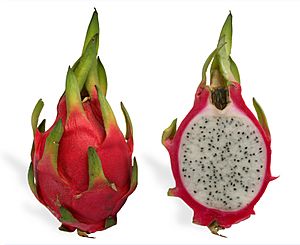 Dragon fruit, a tropical fruit from several different cacti originally from the Americas
Dragon fruit, a tropical fruit from several different cacti originally from the Americas - Citrus fruits such as oranges, lemons, mandarins, etc.
- Banana trees
- Bird of paradise flower
- Palm trees
- Ferns
- Orchids
- Papaya trees
- Dragon fruit
- Bamboo
- Jackfruit
- Giant Water Lily
- Rubber Tree
- Cacao
- Coffee
See also
 In Spanish: Zona intertropical para niños
In Spanish: Zona intertropical para niños
- Hardiness zone
- Tropical ecology
- Tropical marine climate
- Tropical year




